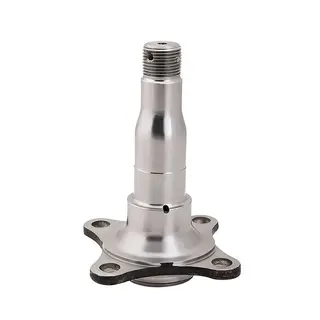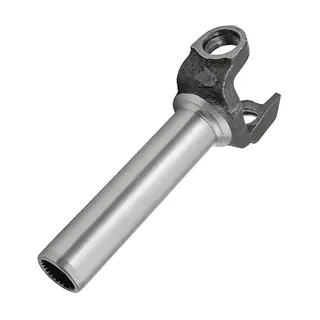With their excellent performance and wide application, carbon steel forgings provide solid assurance for the stable operation of various mechanical equipment. From precision components in automobile engines to heavy parts on railway tracks, from various tools in industrial manufacturing to key components in shipbuilding, and even important supports in power equipment, the presence of carbon steel forgings can be seen everywhere. This article will explore in depth the unique advantages of carbon steel forgings, the secrets of the forging process, and their wide applications in various fields, allowing you to appreciate the charm of this core material in industrial manufacturing.
The reason why carbon steel forgings are widely welcomed is first due to their outstanding mechanical properties. They have high strength, high precision, high toughness, and high production efficiency, capable of withstanding strong impact or heavy load while maintaining light weight and precise dimensions. These characteristics make carbon steel forgings perform excellently in mechanical parts manufacturing, not only giving parts ideal shapes but also optimizing the internal structure of the metal through the forging process, significantly improving its mechanical and physical properties.
The high strength and toughness of carbon steel forgings are one of their core advantages. During the forging process, the metal grains are refined and rearranged under pressure and tension, which helps to improve the mechanical properties of the material, such as strength, toughness, and hardness. Forging can release the internal stress generated by casting, welding, and other processes, thereby enhancing the stability and reliability of the material. The pressure during forging helps to remove the pores and impurities inside the metal, making the material denser and improving its bearing capacity and durability.
By adopting different forging processes and die designs, the shape and dimensions of metal parts can be precisely controlled to meet the manufacturing requirements of various complex parts. The forging process significantly improves the mechanical properties of metals, optimizes the internal structure through plastic deformation, eliminates internal defects, and enhances density and uniformity, thus greatly increasing the tensile strength, toughness, hardness, and fatigue resistance of materials. Forging technology can produce parts with complex shapes and precise dimensions, greatly reducing subsequent machining requirements and improving material utilization efficiency.
Compared with other processes such as casting, forging can achieve a shape closer to the final product, thereby significantly reducing material consumption. Forged parts, due to their excellent mechanical properties, usually have a much longer service life under repeated loads and harsh working conditions than cast or machined parts. The forging process can be flexibly adjusted according to specific needs to produce customized parts that meet specific performance requirements. Forged products often require only a small amount of subsequent processing, such as cutting or drilling, which helps save processing time and cost.
Carbon steel is a carbon-based alloy that contains almost no copper or other elements to enhance different properties. However, the microstructure range of carbon steel is very wide, allowing for a large selection of characteristics. At low temperatures, the microstructure of carbon steel is regularly located in the ferrite phase field except for the carbide phase field, while at high temperatures, the microstructure of carbon steel is in the austenite phase field. Each phase exhibits contrast in crystal structure and, more importantly, contrast in properties. The austenitic phase is mainly for hot working, while the ferritic phase is mainly for cold forging.
Carbon steel performs very well during the forging process. The production itself affects the flexibility, strength, and weaknesses of the final part. Considering the isolation separation, the finishing of pores, and the homogenization provided to carbon steel through manufacturing, this performance improvement occurs. Although carbon steel has a wide range of wear resistance and toughness properties, it should be remembered that production has a very small effect on the strength and consistency of the final parts. Hardness and consistency are generally limited by the preferences of carbon steel manufacturers and the temperature treatment methods.
During hot forging, the temperature of carbon steel usually ranges between 2150°F and 2375°F, slightly lower than the melting temperature exceeding 2500°F. Twisting (adiabatic) heating can cause local heating, and a restricted temperature change of 200°F or higher can lead to limited liquefaction, which will reduce mechanical properties and welding performance. Therefore, it is necessary to strictly control the heating temperature and time during the hot forging process to avoid local overheating and performance degradation.
Warm forging usually occurs in the temperature range of 1500–1800°F and is used to form various grades of carbon steel. The advantage of warm forging is the reduction of energy consumption for heating, while the calculation of volume and temperature compression during post-treatment cooling is simpler. Due to the higher airflow pressure, the press load required for heat output may be much greater than that for forging at normal temperatures. Warm forging is suitable for parts of medium size and complexity, which can maintain good mechanical properties while reducing energy consumption and processing costs.
Cold-forged carbon steel can also be produced below 500°F. Cold forming, for all intents and purposes, is always performed at room temperature because the advantage of raising the temperature by a few hundred degrees is not significant, while the cost of heating is high. The advantages of cold forging are that it requires no heating, has low energy consumption, high machining accuracy, and good surface quality. However, cold forging also has some limitations, such as high requirements for metal plasticity, a tendency to produce cracks during processing, and extremely high demands on the strength and wear resistance of the dies.
Lubrication and protection measures are crucial during the forging process. Lubrication can reduce friction between the metal and the die, improve surface quality and dimensional accuracy, and extend the service life of the die. During hot processing, lubricating grease is usually applied to the die, with graphite being the most well-known lubricant. In cold forging, lubricating grease is applied to the workpiece as a coating. In addition, preventing oxidation and decarburization is also a critical concern during the forging process. Oxidation and decarburization can reduce the surface quality and mechanical properties of the metal, so appropriate protective measures should be taken during heating, such as heating in a neutral or weakly oxidizing medium, to reduce the tendency of oxidation and decarburization.
Due to their excellent performance and wide application range, carbon steel forgings have become an indispensable material in modern industrial manufacturing. They are widely used in automobiles, railway transportation, industrial manufacturing, shipbuilding, and electric power, providing strong assurance for the stable operation of various mechanical equipment.
In automobile manufacturing, carbon steel forgings are widely used in engines, transmissions, suspension systems, and other key components. For example, engine crankshafts, connecting rods, and gears need to withstand high-impact forces and heavy loads. The high strength and toughness of carbon steel forgings make them the ideal choice. In addition, the lightweight characteristics of carbon steel forgings also help to improve fuel efficiency and vehicle performance.
In railway transportation, carbon steel forgings are used to manufacture key components such as rails, wheels, and axles. These components must bear enormous weight and frequent impacts. The high strength and toughness of carbon steel forgings can ensure the safe operation of railway systems. Meanwhile, the precise dimensions and shapes of carbon steel forgings also help improve the stability and reliability of railway systems.
In industrial manufacturing, carbon steel forgings are used to produce various tools, dies, and mechanical parts. These parts need to have high strength, high precision, and high wear resistance. The excellent performance of carbon steel forgings makes them the preferred material. In addition, the material-saving and efficient production characteristics of carbon steel forgings help to reduce production costs and improve production efficiency.
In shipbuilding, carbon steel forgings are used to manufacture key components such as hull structures, engine parts, and propellers. These components must withstand seawater corrosion and high-impact forces. The high strength, toughness, and good corrosion resistance of carbon steel forgings make them an ideal choice. At the same time, the lightweight characteristics of carbon steel forgings also help improve the navigation performance and fuel efficiency of ships.
In power equipment, carbon steel forgings are used to manufacture key components such as generators, transformers, and high-voltage switches. These parts must have high strength, high precision, and high reliability. The excellent performance of carbon steel forgings makes them the preferred material. In addition, the material-saving and efficient production characteristics of carbon steel forgings help reduce production costs and improve production efficiency.
With their excellent performance and wide application range, carbon steel forgings have become an indispensable material in modern industrial manufacturing. Through the optimization of the forging process, carbon steel forgings can achieve high strength, high precision, high toughness, and high production efficiency, while significantly improving the mechanical properties and service life of materials. In automobiles, railway transportation, industrial manufacturing, shipbuilding, and power industries, carbon steel forgings play an important role, providing solid assurance for the stable operation of various mechanical equipment. With the continuous development and innovation of forging technology, the performance and application range of carbon steel forgings will be further expanded, making greater contributions to the development of modern industry.



